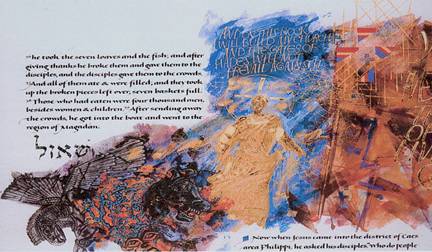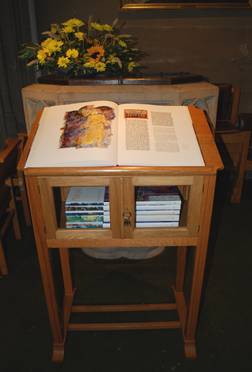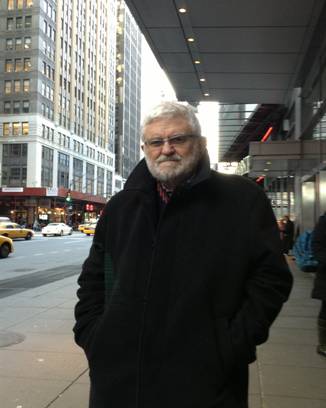We
have, in our small parish church, the seven volumes, all now commercially
available, of the
St. Johnís
Bible, the original MSS being in
St Johnís College
,
Minnesota
in the
US
. It is placed in a wooden cabinet in front of the Font as
you come into church, with a display lectern available for reading the text. It
is a most beautiful piece of craftsmanship. The artwork is simply stunning.
The
St
Johnís
Bible

Saint Benedict
taught that all tools, however humble, should be handled with the care given to
the sacred vessels of the altar. For centuries, this ethic has been embodied in
Benedictine life and work.
The
Benedictine monks of
Saint John's
Abbey arrived
in
Minnesota
in 1856. In
1965,
Saint John's
revived the
Benedictine tradition of manuscript copying by establishing a library dedicated
to the photographic preservation of singular documents. Forty years and 100,000
manuscripts later, the Hill Museum & Manuscript Library holds in trust the
largest collection of manuscripts in the world.
By
commissioning The Saint John's Bible, the Abbey and University brought
1,500 years of Benedictine religious and creative experience together with their
conviction that manuscripts are uniquely privileged media for expressing
humankind's deepest memories and aspirations. With keyboards everywhere, how
many of us pen a letter or write any extended piece of work by hand? It just
doesnít happen. Yet this text, hand-written though it is, used extensively
modern computing techniques to achieve something beautiful.
As
Senior Scribe to Her Majesty the Queen's Crown Office at the House of Lords,
Donald Jackson had reached the pinnacle of his profession. But for years he had
an unrealized dream: to write the Bible by hand.
Saint
John's
Abbey and
University dared to imagine with
Jackson
an illuminated
Bible for the 21st Century, a Bible handwritten in English. In his
scriptorium in
Wales
, Donald Jackson
assembled a team of scribes and artists who shared this vision. In bringing it
to life, they have used only materials associated with enduring manuscripts:
carefully prepared calfskins, hand-cut goose quills, century-old inks, and
precious metals.
On
April 28th 1998
, Donald Jackson and
Brother Deitrich Reinhart OSB, signed the Contract which officially launched The
Saint Johnís Bible. Donald used a quill pen and brilliant red ink. Together
they embarked on a collaboration that would last almost a decade. The
St Johnís
Bible is a modern
manuscript book, the first hand-written Bible since the printing at Gutenburg in
the 1450ís. Written in
Latin, the Gutenberg Bible is an edition of the Vulgate printed by Johannes
Gutenburg, in Mainz, Germany. It
recaptures the spirit of the great medieval Bibles, yet it expresses an
awareness of contemporary artistic experience. It treats the theology of the
text with the same sensitivity to modern awareness.
The
St Johnís
Bible is a reflection of
the monastic devotion to the Scriptures. The painstaking work of making the
Bible echoes the slow meditative reading which is a hallmark of Benedictine life
and Spirituality. Back and forth across the
Atlantic
, the exchanges on text,
style and artwork continued over a number of years till, with its conclusion, it
now finds a home with the Benedictines in
Minnesota
.
Placing
it where it is in our parish church, next to the font, reminds us that
Scriptural texts are at the foundation of our faith. If you havenít come
across it, check out the website details below.
Published in seven volumes:
|
 |
∑
Gospels & Acts
∑
The Psalms
∑
The Prophets
∑
Wisdom
∑
The Pentateuch
∑
Letters and Revelation
∑
History Books
|
Web site:
www.saintjohnsbible.org
The
full story of the production of the
St Johnís
Bible is told in the book ďIlluminating the WordĒ by
Christopher Calderhead. Well worth reading.
Pub
Liturgical Press
US
2005
ISBN-10:
0814690505 ISBN-13: 978-0814690505
-----
Comments
welcome here



